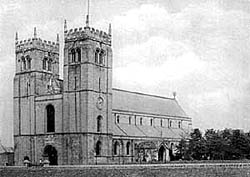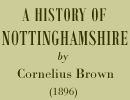< Previous | Contents | Next >
 Worksop Priory in 1900.
Worksop Priory in 1900.At Worksop the priory church of SS. Mary and Cuthbert is one of great magnificence, and of cathedral-like proportions. When the Augustinian priory was founded, part of its original endowment consisted of the parish church, which Mr. White believes to have been a small Norman edifice terminating in an apse at its eastern end. The Augustinians were great builders, and the sacred edifice was rebuilt on a scale of unusual grandeur A.D. 1170-1180, to which date almost the whole of the present fabric is attributable. The western front has lofty twin towers, and the west doorway possesses a recessed arch with zigzag ornament. A very striking feature is the nave with its unbroken aisle, and arcades supported by eight solid pillars.
The following additional notes have been kindly supplied by Mr. John T. Godfrey, the author of ‘The Churches of Notts of the Hundred of Rushcliffe,’ and other local works:
Though the parochial churches of Nottinghamshire do not possess any marked local architectural features, such as may be seen in the towers of Somersetshire, the wooden roofs and spires of Norfolk and Suffolk, or the double-naved churches of Cornwall, yet many of them are of considerable interest. Omitting the cathedral church of Southwell, and the conventual churches of Blyth, Worksop and Thurgarton, and the remains of Newstead, to which previous reference has been made, the following list, although not exhaustive, will be found to include the more interesting churches in the county:
NORMAN: Balderton, porch-arch on north side, and corresponding doorway on south side; Carlton-in-Lindrick, doorway in tower, and north arcade of nave; Carlton-on-Trent, doorway; Caunton, indications in westernmost arch of south aisle arcade; Everton, tower arch; Hockerton, chancel arch, jambs of tower arch, doorway within the porch, a corresponding one in the north wall, and a small light in the south wall of nave; Hucknall, lower part of tower; Kirklington, doorway within porch ; Laneham, doorway; Linby, doorway within porch; Mansfield, lower part of tower; Plumtre,lower part of tower; Rolleston, doorway; South Leverton, tower; South Muskham, lower stage of tower, and doorway in north aisle; Teversall, doorway within porch; Whatton, lowerstage of tower.
EARLY ENGLISH: Averham, chancel; Balderton; Bingham, tower; Burton Joyce, nave; Car Colston, nave and lower part of tower, Caunton, nave and chancel; Coddington, lower part of tower; Cotgrave, nave; Cromwell; Elston, nave; Everton, nave; Farndon, nave; Finningley, chancel; Flintham, chancel; East Leake; Edwalton; Gedling, nave and chancel; Gotham, tower and spire; Halloughton, chancel; Hawton, nave and doorway in north aisle; Keyworth, chancel; Kingston-on-Soar, remains; Kneesall, nave, south aisle, and chancel; Langar; Linby, chancel; Mansfield, nave; Maplebeck; Newark, lower part of tower; Normanton-on-Soar; North Muskham, tower arch, north aisle arcade; Norwell, lower stages of tower, chancel, aisle arcades, and doorway within porch; Nottingham (St. Peter), nave; Orston, nave and chancel; Plumtre, nave and south aisle; Radcliffe-on-Soar; Rolleston, except tower; Screveton, chancel, nave, and aisles; Shelford, nave and chancel; South Leverton, nave and chancel; South Muskham; Sturton-le-Steeple, nave; Sutton Bonington (St. Anne), aisle and chancel; Sutton-on-Trent, lower stages of tower and nave arcades; Teversall, chancel; Thoroton, nave; Thrumpton, nave; Upton, nave; Wellow, tower; West Bridgeford; Whatton, aisle arcades; Wilford, nave, south aisle, and porch; Willoughby-on-the-Wolds.
DECORATED: Annesley, Felley priory chapel; Averham, tower-arch, south porch; Barton-in-Fabis; Bilsthorpte, chancel; Bingham, aisles, transepts, and spire; Bunny, nave, aisles, tower, and spire; Burton Joyce, aisles, chancel, tower, and spire; Car Colston, chancel; Caunton, aisles; Costock; Cotgrave, tower;Cromwell, tower;East Bridgeford porch; East Stoke, windows; Everton, chancelarch; Flintham, windows; Gedling, tower; Gotham, aisles; Holme, broach spire; Hawton, aisles and chancel; Keyworth, nave; Kirklington; Mansfield, windows; Mansfield Woodhouse, tower and spire; Newark, south aisle, upper part oftower, and spire; Norwell, porch, south aisle, and transepts; Nottingham (St. Peter), tower and spire; Orston, aisles; Rolleston, windows; Ruddington, tower; Scarrington, windows; Screveton, tower; Shelford, aisles; Sibthorpe, chancel; Stanford-on-Soar, chancel; Staunton; Sutton-in-Ashfield; Sutton-on-Trent, south aisle; Sutton Bonington (St. Anne), nave; Thoroton, tower and spire; Thorpe, windows; Thrumpton, chancel; Upton, windows;West Bridgeford, windows; West Leake, nave and chancel; Whatton, windows; Widmerpool, tower; Wysall.
PERPENDICULAR: Averham, tower; Blidworth, tower; Car Colston, upper part of tower; Caunton, tower; Clifton, chancel; Cotgrave, chancel; East Markham, tower; East Retford, tower; Finningley, nave and northaisle; Gedling, spire; Hawton, tower: Kelham, tower; Keyworth, tower; Kneesall north aisle and upper stages of tower; Newark, chancel, north aisle; North Muskham, tower, and south aisle arcade; Norwell, upper stage of tower; Nottingham (St. Mary); Ordsall, tower; Plumtree, chancel; Rolleston, tower; Scrooby; Shelford, tower; South Muskham, tower; Sturton-le-Steeple, tower; Sutton Bonington (St. Michael), tower; Sutton-on- Trent, north aisle, chancel, and chapel; Clifton, tower; West Bridgeford, tower; West Retford, spire; Wilford, chancel
